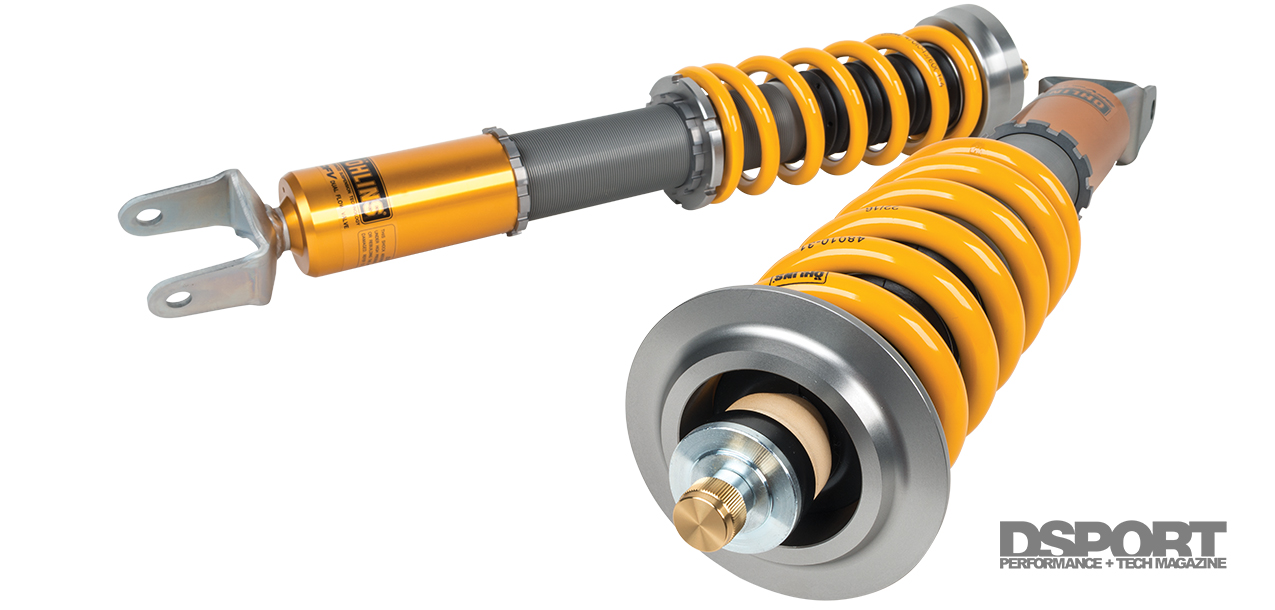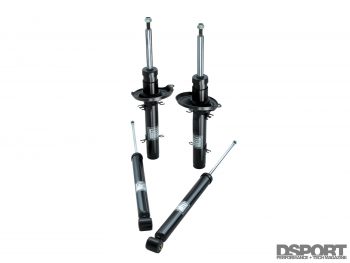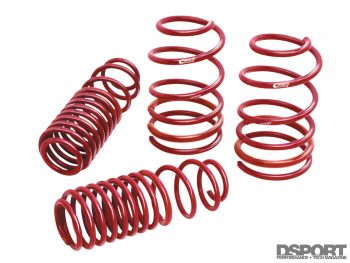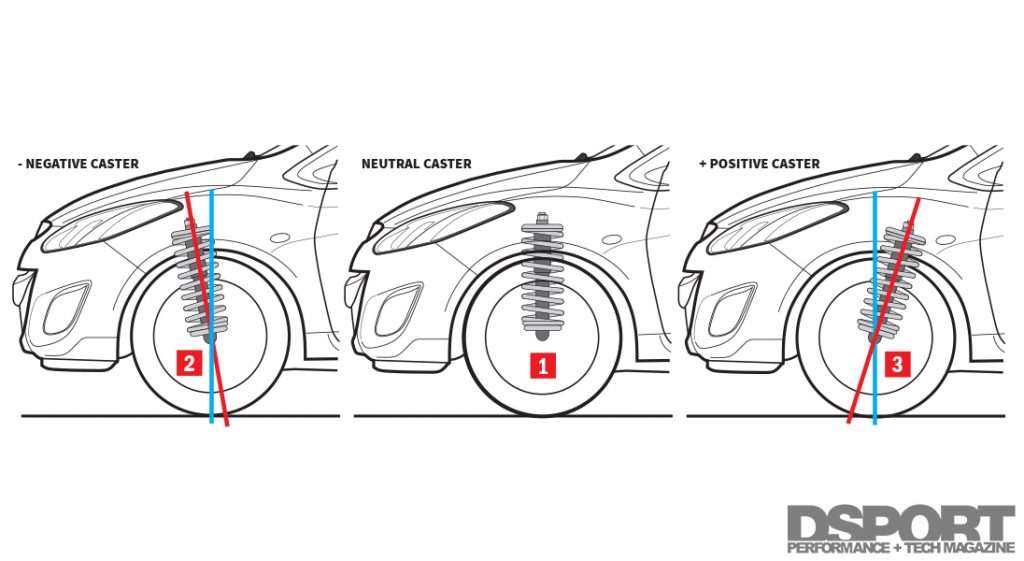Racecar drivers that double as engineers will almost always excel in competition. However, the backseat-driver-equivalent of engineers that claim to be racecar drivers are the worst. These types that love to chase setup adjustments down to the molecular level, they treasure logged data and long debates about spring rates, chassis flex and roll centers. While most of their hypothetical ramblings aren’t wrong, the level of detail in their arguments frequently prove irrelevant in real world situations. One of the most important lessons anyone can learn in tuning their suspension is to fully understand how the different components work together and to never overthink it.
By Cameron Parsons
DSPORT Issue #171
Shocks and Springs
When discussing the concept of suspension, the first items that come to mind for most are springs and shock absorbers. Despite the names of these components, most aftermarket springs and shocks are anything but soft. The springs work to soften bumps and impacts in the road, however, springs without shock absorbers would bounce the car around like a pogo stick. The shock absorbers prevent this effect with the help of oil or gas valving to limit the spring oscillations.
Lowering springs provide a quick and affordable method to improving a car’s look and handling. These springs replace the factory coils with a shorter and stiffer option. Lowering the car will drop its center of gravity for better handling while improving its looks (as long as it’s not slammed to the ground). In order to prevent bottoming out or overusing the suspension components, lowering springs generally run stiffer than factory equipment. If you go down this road, keep in mind that the springs may alter the functionality of the factory shock absorbers by preloading them at all times, leading to over-pressurization and blown seals. A set of lowering springs with performance shocks to match is your safest bet toward improved performance and longevity.
Strut and Spring Upgrades
Some manufacturers offer upgrades to replace factory struts and springs for users who are not quite ready to make the leap to higher-priced adjustable coilovers. Since lowering springs can potentially damage the factory struts, it is often recommended to upgrade the struts and springs together to enhance the car’s handling.
Coilovers
While many streetcars utilize shock absorbers and springs as two separate components, performance applications frequently utilize a coilover suspension configuration, where the spring surrounds the shock absorber in a single unit. This setup often allows for fine tuning with the ability to change out different rated springs and to manually or electronically adjust the shock absorber settings. You may have heard of one-way, two-way, three-way and even four-way adjustable coilovers. These settings allow users to tune the compression (bump) and rebound phases of the shock absorber down to very fine detail.
Why does this level of tuning matter? When navigating a car through a corner on the track, the driver must brake, turn in, apex, accelerate and track out. Every step of the way through this corner, the car experiences shifts in inertia, weight transfer and alignment angles. A properly tuned suspension aids in shifting the car’s weight to the right places at the right time, while pressing the tires down on the pavement for maximum grip. Excessively low settings in compression and rebound make the car feel soft and less responsive. On the other end, too high of settings reduce the effects of the suspension, making for a very unsettled car that won’t grip the road.
Unlike the switch to lowering springs, coilovers provide users with the means to raise and lower the car. Since each strut is adjustable, users can adjust the vehicle’s height at each individual corner to set the weight distribution to their liking. This helps massively in improving the handling capabilities and the overall balance of the vehicle. Dialing in a proper crossweight isn’t easy, but it can make a car drive like a dream.
Damper Effect
Shock absorbers, also known as dampers, reduce the springs’ tendency to bounce or oscillate excessively. This is done with carefully tuned oil valving inside the shock absorber, designed to control the motion and travel of the suspension for both comfort and handling performance.
Alignment
Cornering ability can improve tenfold by properly aligning your vehicle’s suspension. This means to stray far away from slamming your car to the ground and cranking negative camber to extreme angles for that unsightly “stanced” look. With the help of adjustable suspension arms, you can make quick changes to the alignment in all directions, in the search for better performance. The three key alignment factors include camber, caster and toe.
Camber is the vertical angle of the wheels perpendicular to the road. If the top of the wheels tilt inward, they are running negative camber. If they tilt outward on top, they are running with positive camber. Typically, negative camber increases grip with few unwanted side effects. This angle aids in utilizing the tire’s entire available contact patch while also loading some of the cornering forces vertically on the tire instead of sideways. Taking this setting too far, however, reduces how much contact the tire makes with the road. This results in poor handling, uneven tire wear and a serious strain on the suspension.
Caster Settings
(1) Caster is based on the axis at which the wheel pivots or turns. If this axis were straight up and down, the car would have neutral caster.
(2) Positive caster increases negative camber gain while turning, thus increasing grip. It also improves straight-line stability, but at the cost of increased steering effort.
(3) Dialing the setup toward negative caster reduces effort required to turn the wheel. However, cars do not utilize negative caster as it causes the vehicle to wander.
Caster is best represented by the vertical axis that the front wheels turn on. In most cases, the more positive caster you can add, the better. This setting benefits the car with additional camber on the front wheels as they turn left and right. Positive caster also helps the front wheels self-center, making the car more stable in a straight line. Although positive caster comes with some great advantages, excessive settings can be detrimental. As the caster angle is increased, steering effort and tire wear go up with it.
Dialing in proper toe is one of the easiest alignment settings to change with the biggest payoff in performance and lap times. Most streetcars utilize toe-in on the front wheels because it offers better straight line stability at the sacrifice of responsiveness. Racecars go with the opposite, running very slight toe-out on the front wheels to help with turn-in. When turning into a corner, toe-out enables the inside wheel to angle more aggressively and with a tighter turning radius than the outside wheel, better pulling the car into the corner. Although this setting works great on the racetrack, it can make the car feel twitchy and overly sensitive to changes in the steering wheel.
The Lowdown
Alignment can be seen as both a performance upgrade and an essential maintenance item. Any time that you make a major change to the car’s suspension, such as lowering springs or coilovers, realigning the wheels is a must. When the car squats lower than the factory settings, the shape of the suspension arms tend to increase negative camber and front wheel toe-out. Depending on how aggressively the car is dropped, this can throw the alignment settings way off and damage your suspension and tires. To this end, your first stop after lowering your car should be the alignment shop.
Adjustable Suspension Arms
Adjustable suspension arms, or links, provide the ability to make quick changes to the vehicle’s alignment. This feature enables users to fine tune the car’s setup quickly and easily in the garage or at the racetrack.
Chassis
Any changes to the suspension system, from coilovers to alignment angles, translate through the vehicle’s chassis. Polyurethane bushings, thicker sway bars and numerous forms of chassis bracing can assist in maximizing the effects of the remaining suspension components. Many streetcars are designed with comfort taking priority over performance. This results in a softer chassis that will better absorb bumps and inconsistencies in the road surface, but will also flex and twist when travelling around corners at speed. This slows the time it takes for the car to transfer load where needed, leading to poor responsiveness. When upgrading to components that focus on stiffening the chassis, the car’s responsiveness and handling improve greatly. However, completely removing all flex from the car will reduce its ability to transfer any load at all. Components like sway bars and some chassis braces include multiple settings for stiffness, so that you can fine tune the front and rear balance of the car’s chassis settings.
Did You Feel That?
The key to dialing in your suspension is not only understanding how your car handles in the corners, but also why it handles the way it does. Analyze the car’s performance and consider items such as weight transfer, chassis flex, tire temperatures and most importantly the driver’s technique. The ability to distinguish these characteristics from one another doesn’t come naturally to anyone. But with a lot of seat time and the patience to test and trial different suspension settings, you can get a feel for how changes in each component help or hurt the overall handling.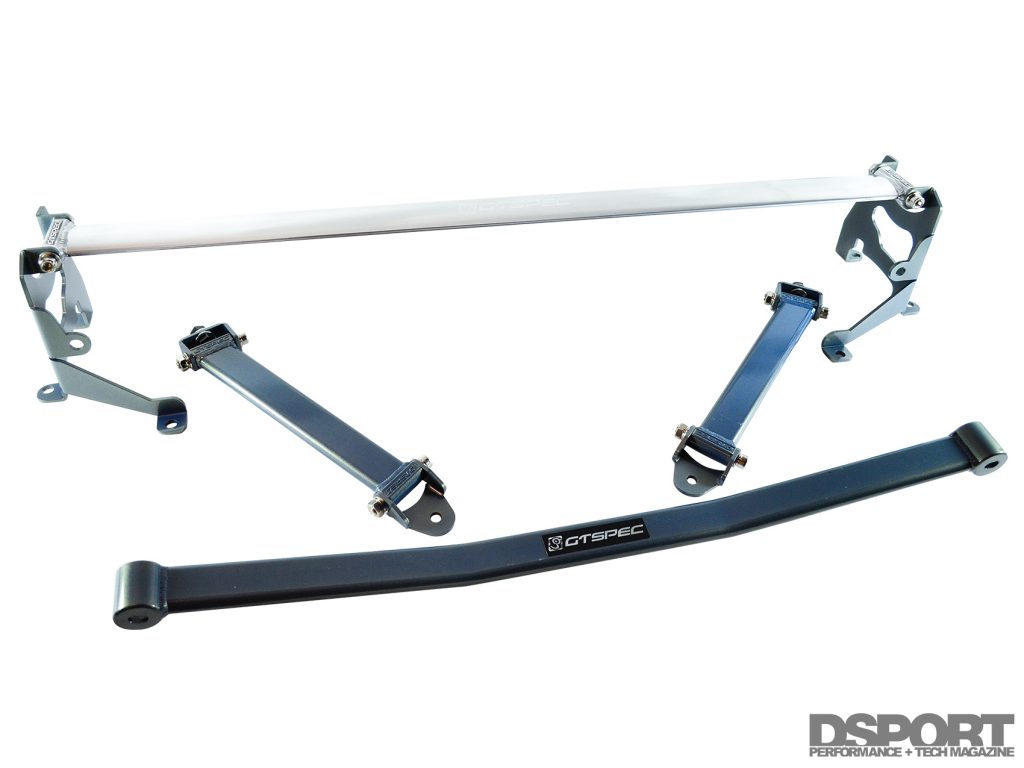
While sway bars reduce body roll by tying suspension points together, chassis braces aim to reduce flex in the chassis itself.
The key here is to make only one change at a time. Did the car oversteer only on entry but not on exit? Test a different shock setting to adjust how the weight transfers throughout the corner. Does the car push through corners around the entire track? Try a different sway bar or alignment setting that affects front end grip. Dialing in your suspension setup is one of the most difficult tasks to accomplish, given the many “it depends” situations that get thrown at you. Take your time, drive consistently, log every change and analyze the results. Once you’re headed in the right direction, you’ll find yourself moving up the leaderboard.
Bolt-On Basics | Performance Tuning 101
• Air Intake Systems – The Pathway to More Power
• Exhaust Systems – Uncorking Your Engine’s Potential
• ECU Tuning – Harnessing the Power of Technology
• Fuel Systems – Quench Your Engine’s Thirst
• Forced Induction Systems -Boost for Max Power
• Cooling Systems – Less Heat for Longer Life and More Power


